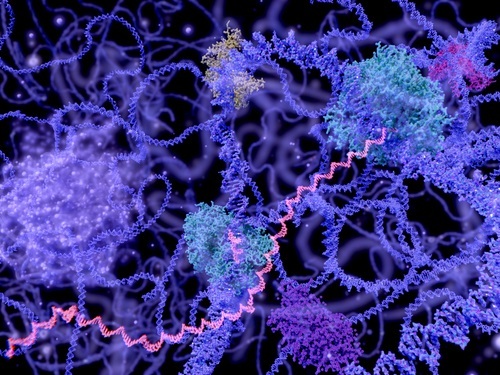
 Data Structure
Data Structure Networking
Networking RDBMS
RDBMS Operating System
Operating System Java
Java MS Excel
MS Excel iOS
iOS HTML
HTML CSS
CSS Android
Android Python
Python C Programming
C Programming C++
C++ C#
C# MongoDB
MongoDB MySQL
MySQL Javascript
Javascript PHP
PHP
- Selected Reading
- UPSC IAS Exams Notes
- Developer's Best Practices
- Questions and Answers
- Effective Resume Writing
- HR Interview Questions
- Computer Glossary
- Who is Who
LTR Retrotransposon and its Structure in Eukaryotes
Introduction
Retrotransposons are genetic elements that are capable of replicating and inserting themselves into different parts of the genome. They are found in almost all organisms, including bacteria, archaea, and eukaryotes. Retrotransposons can be divided into two major classes: non-LTR retrotransposons and LTR retrotransposons. In this article, we will focus on LTR retrotransposons, their structure, and their role in eukaryotic genomes.

LTR retrotransposons, also known as Ty elements, are a type of retrotransposon that contain long terminal repeats (LTRs) at their ends. These LTRs are similar in structure to retroviral LTRs, which are also found in viruses that integrate into the host genome. The LTRs are typically 100-500 bp in length and are composed of three regions: U3, R, and U5.
The U3 region is located at the 5' end of the LTR and contains the promoter region for transcription of the retrotransposon. The R region is in the middle of the LTR and contains sequences that are involved in the integration of the retrotransposon into the genome. The U5 region is located at the 3' end of the LTR and contains sequences that are involved in the reverse transcription of the retrotransposon.
Structure in Eukaryotes
The internal structure of LTR retrotransposons is like that of non-LTR retrotransposons. They contain a long open reading frame (ORF) that is flanked by LTRs at each end. The ORF encodes a polyprotein that is processed into individual proteins, including a reverse transcriptase (RT), integrase (IN), and protease (PR). These proteins are necessary for the retrotransposon to replicate and integrate into the host genome.
The RT protein is responsible for reverse transcription of the retrotransposon RNA into DNA. It uses the retrotransposon RNA as a template to synthesize a complementary DNA (cDNA) strand. The cDNA strand then serves as a template for the synthesis of a second DNA strand, resulting in a double-stranded DNA molecule that is integrated into the host genome.
The IN protein is responsible for the integration of the retrotransposon into the host genome. It cleaves the host DNA and inserts the retrotransposon DNA into the resulting gap. The PR protein is responsible for the processing of the polyprotein into individual proteins.
LTR retrotransposons are found in all eukaryotic genomes, and their abundance can vary greatly between different species. For example, LTR retrotransposons make up about 8% of the human genome, while they make up about 40% of the maize genome. LTR retrotransposons can be further divided into two subclasses: Ty1-copia and Ty3-gypsy. As mentioned earlier, LTR retrotransposons in eukaryotes have a structure that consists of long terminal repeats (LTRs) at their ends and an internal open reading frame (ORF) that encodes a polyprotein.
The LTRs are typically 100-500 bp in length and contain three regions: U3, R, and U5. The U3 region contains the promoter for transcription of the retrotransposon, the R region contains sequences for integration, and the U5 region contains sequences for reverse transcription.
The polyprotein encoded by the internal ORF is processed into individual proteins, including a reverse transcriptase (RT), integrase (IN), and protease (PR). The RT protein is responsible for reverse transcription of the retrotransposon RNA into DNA, the IN protein is responsible for the integration of the retrotransposon into the host genome, and the PR protein is responsible for the processing of the polyprotein into individual proteins.
LTR retrotransposons can be further classified into two subclasses: Ty1-copia and Ty3-gypsy. The Ty1-copia subclass is characterized by a shorter RT domain and a longer IN domain, while the Ty3-gypsy subclass is characterized by a longer RT domain and a shorter IN domain. These subclasses also differ in their chromosomal distribution, with Ty1-copia elements being more frequently found near telomeres and centromeres, while Ty3-gypsy elements are more uniformly distributed throughout the genome.
In eukaryotes, LTR retrotransposons can make up a significant proportion of the genome, ranging from 8% in humans to 40% in maize. The abundance of LTR retrotransposons can vary greatly between different species, and their activity can also vary depending on environmental factors, such as stress or infection.
The role of LTR retrotransposons in eukaryotic genomes is complex and multifaceted. They have been responsible for the creation of new genes and regulatory elements by inserting themselves into non-coding regions of the genome. They have also been responsible for the rearrangement of chromosomes by inserting themselves into genes and causing mutations. In addition, LTR retrotransposons can have a role in the regulation of gene expression by acting as enhancers or promoters for nearby genes.
Despite their potential for causing genomic instability and mutations, LTR retrotransposons have been co-opted by the host genome for various functions. For example, some LTR retrotransposons have been domesticated and evolved into functional genes, such as the syncytin genes in mammals that are involved in placental development.
Conclusion
LTR retrotransposons are a type of retrotransposon that are found in eukaryotic genomes. They have a characteristic structure that includes LTRs at their ends and an internal ORF that encodes a polyprotein. LTR retrotransposons can be further classified into two subclasses, Ty1-copia and Ty3-gypsy, which differ in their chromosomal distribution and protein structure. Despite their potential for causing genomic instability, LTR retrotransposons have played an important role in the evolution of eukaryotic genomes and have been co-opted for various functions by the host genome.

